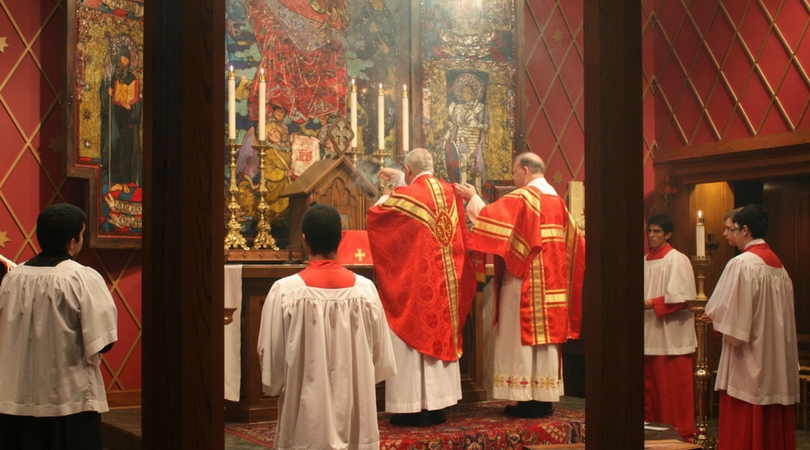
The Divine Worship Mass, otherwise known as the DWM, is a traditional Catholic liturgy of the Eucharist that is celebrated in Sacred English (thee, thou, thy, thine, etc.) as typically seen in traditional English translations of the Bible and prayer books. It follows the basic pattern of the standard Ordinary Form Mass (Novus Ordo or “New Order”) that is used in most Catholic parishes today, but is oriented in tradition more toward the Extraordinary Form Mass (Vetus Ordo or “Old Order,” commonly called the Traditional Latin Mass, or TLM). In this sense, the Divine Worship Mass (DWM) is celebrated with the priest facing liturgical east (ad orientem) along with the congregation, especially during the Liturgy of the Eucharist, similar to the way it’s celebrated in the TLM. Communion is distributed on the tongue while kneeling, and never in the hand, identical to the TLM. In addition to Sacred English, the DWM also uses special prayers, chants and hymns brought over to the Catholic Church from the Book of Common Prayer, a staple of Christian worship used in England, and English colonies, for centuries. An example of Divine Worship can be seen in the video below. This is the Divine Worship Mass at the Church of the Annunciation in Orlando – Celebrated by Bishop Steven J. Lopes on August 13th, 2017…
Officially, this liturgy belongs to the “Ordinariates of English Patrimony” (or the “Ordinariates of Anglican Patrimony” if you prefer). There are three such ordinariates worldwide: in the United Kingdom, Anglo-America, and Oceania. DWM locations can be found on the websites for these ordinariates. Likewise, the Anglicanorum Coetibus Society (ACS) keeps track of such mass locations, as well as startup groups looking to establish new DWM locations…
Let me make this crystal clear. All Ordinariate members are Roman Catholics. They are not Anglicans. They are, rather, Roman Catholics who have a devotion to the English Patrimony.
A Divine Worship Mass (DWM) is not limited to English alone. There is a Spanish translation used in some Spanish-speaking Ordinariate parishes in the United States. It is possible that Divine Worship could be translated into any language where Anglicanism was historically established, should the need arise. The DWM is a strictly Catholic liturgy, which comes to us from the English Patrimony.
The English Patrimony has also been used by Anglicanism for five centuries and Methodism for three centuries. The Catholic Church used the English Patrimony for eight centuries prior to the Protestant Reformation, particularly in the celebration of the Sarum Use Mass, and readopted it about four decades ago (1980) as an English re-adaptation initially for Anglican (Episcopalian) converts in the United States. The English Patrimony is the liturgical heritage of all Christians connected to England around the world, whether Catholic, Anglican or Methodist. Both the Douay–Rheims Bible (1582 – 1610) and the King James Bible (1611) draw heavily from the linguistic aspects of the English Patrimony.
Let me make this crystal clear. The Catholic Church now has an English Patrimony. This patrimony was originally invented by the Catholic Church between AD 664 and 1534, during a span of 870 years. It was then taken away from the Catholic Church at the English Schism in 1534, and remained outside of the Catholic Church until 1980, a span of 446 years. In 1980 it was readopted into the Catholic Church. Today it is flourishing within the Catholic Church once again.
The standard handbook for lay Catholics wishing to familiarize themselves with the English Patrimony is the St. Gregory’s Prayer Book, but nothing beats going to a DWM and participating in the liturgy.
The DWM is not a separate rite, but rather another form of the Roman Rite, and the ordinariates fall under the same Code of Canon Law used by most Catholics in the West. Therefore, regular Roman Catholics can attend these liturgies regularly, and even join these parishes without problem.


It is an English Mass as if the faith were true 😦
LikeLike